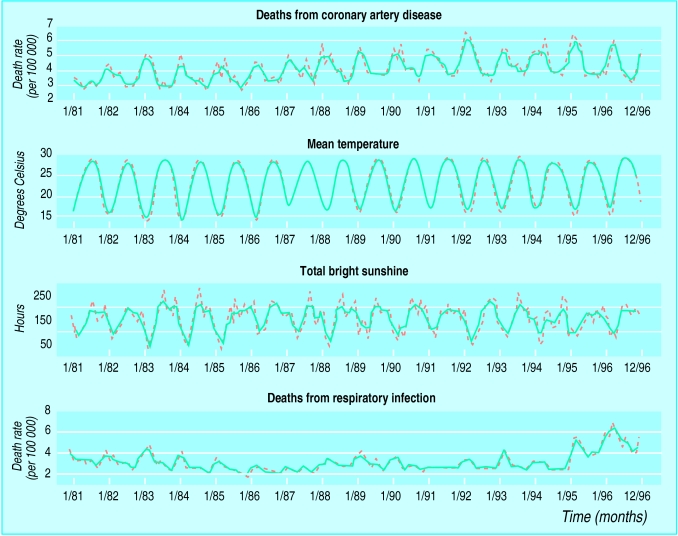Editor—Seto et al’s findings of seasonal variation in mortality from coronary artery disease in Hawaii1 are similar to our own findings in Hong Kong, a subtropical city.
Hong Kong has 6.2 million people residing and working in an urban and suburban area of about 1070 km2. In summer and autumn (May-October) the temperature is warm (mean 27°C; range 22-30°C); in winter and spring (November-April) it is an average of 8°C cooler (19°C; 7-27°C).
As a single disease entity, coronary artery disease (ICD-9 410-414) emerged as the biggest killer in Hong Kong (3181 deaths in 1992). The sex difference in mortality is smaller than in other parts of the world; for the 40-69 age group the male to female ratio was 2.4 compared with 2.8 for the United States and 3.3 for England and Wales, and prevalence was greater in higher than in lower socioeconomic groups. The age standardised mortality (based on Segi’s world populations2) from 1972 to 1992 stayed close to 60/100 000 for men and slightly above 30/100 000 for women—lower than in all countries except Japan,3 and less than half the rate in Hawaii.
The crude death rates for coronary artery disease, with three month moving averages (figure), show a strong seasonal variation and, compared with Hawaii, a stronger correlation with temperature (r=−0.60 v −0.55), total hours of bright sunshine (r=−0.30 v −0.27) and deaths from respiratory infection (r=0.53 v 0.41), P<0.001 for all. The difference between the peak month (January) and trough month (September) was greater than that in Hawaii (37% v 22%) and the figures quoted for Scotland and New Zealand.
Seto et al interpret their data as showing that small changes in weather may affect mortality. In Hawaii, although monthly variation in temperature was small, the changes in hours of sunlight were marked and would be highly correlated with temperature.
The magnitude of seasonal variation in both coronary artery disease and respiratory deaths in the subtropical city of Hong Kong is stronger than that in the Hawaiian tropical climate and comparable to or greater than that in other temperate zones. Studies in seasonal variation of disease may shed light on the cause of terminal events in coronary artery disease.
Figure.
Seasonal variation (broken line shows three month moving average) in monthly death rates from coronary artery disease, with average temperature, hours of sunlight, and deaths from respiratory infection
References
- 1.Seto TB, Mittleman MA, Davis RB, Taira DA, Kawachi I. Seasonal variation in coronary artery disease mortality in Hawaii: observational study. BMJ. 1998;316:1946–1947. doi: 10.1136/bmj.316.7149.1946. [DOI] [PMC free article] [PubMed] [Google Scholar]
- 2.Waterhouse J, Muir C. Cancer incidence in five continents. Vol. 4. Lyons: International Agency for Research on Cancer; 1992. p. 675. [Google Scholar]
- 3.Department of Health; University of Hong Kong. Public health report No 1: a new approach to public health report, coronary heart disease and lung cancer. Hong Kong: Department of Health; 1994. Coronary heart disease in Hong Kong; pp. 14–32. [Google Scholar]



